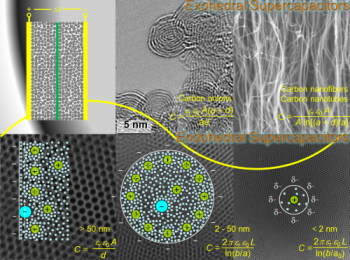Yury Gogotsi of Drexel University with his co-workers felt the necessity of studying a potential supercapacitor material at the atomic level to analyze certain experimental results. A research team under the supervision of Oak Ridge National Laboratory’s (ORNL) computational physicist Vincent Meunier and computational chemists Jingsong Huang and Bobby Sumpter enabled the analysis at the atomic level.
 Computational modeling of carbon supercapacitors with the effects of surface curvature included.
Computational modeling of carbon supercapacitors with the effects of surface curvature included.
Gogotsi's team found that it is possible to augment the energy present in a carbon super capacitor significantly by decreasing the size of pores in the material to almost an impossible size. The size of the pores was very small when compared to the size of solvent-covered electric charge-carriers that should ideally fit inside them.
The energy accumulated was in the form of ions enclosed by shells of solvent molecules and filled on the nanoporous carbon’s surfaces. The researchers could reduce the size of pores in carbon to about 0.7 to 2.7 nm. They found that the material’s stored energy increased remarkably as the pores reached a size below a nanometer, despite the fact that the ions in solvation shells could not accommodate themselves in such tiny spaces.
Sumpter and his team used ORNL's Jaguar and Eugene supercomputers, to observe the interaction between the carbon surface and the ion at the nanoscale level. They utilized a computational approach called density functional theory to demonstrate that Gogotsi phenomenon was very much possible. In fact, they observed that the ion gets out of its solvation shell with ease and accommodates into the nanoscale pore. Using electronic structure calculations, they derived a model to estimate the capacitance for various types of pore sizes and curved shapes. The calculations proved that the charge-carrying ions get stored not only by accommodating in the pores but also attach themselves to the material’s mounds. The ORNL team collaborated with researchers at Rice University to construct a functional supercapacitor with atom-thick sheets of carbon.